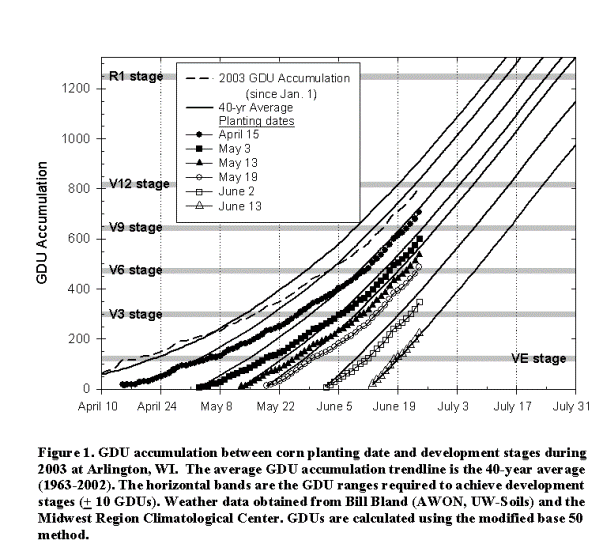Tracking Corn Growth and Development: Survival and Projecting Key Stages
June 26, 2003 10(15):
Joe Lauer, Corn Agronomist
Growing degree unit accumulation has been average over the past week through the
recent warm weather. The April 15 planting date is past V9 and is near lay-by. Lay-by
is the plant height at which it is difficult to get normal equipment into the field
to perform management operations because the crop is too tall. Lay-by usually occurs
for corn between V10 and V12.
If temperature for the remaining growing season follows average trends, the April
15 planting date is projected to be at V12 by June 30, and the May 3 planting date
will be at V12 by July 5 (Figure 1). Any final field operations will need to be
performed over the next week. The April 15 and May 3 planting dates should be at
the R1 (silking) stage by July 21 and 26. The last planting date on June 13 will
not achieve V12 until July 23 and R1 on August 14.
Around V9, the stalk is in a period of greatly increased elongation. Stalk elongation
actually occurs through elongation of its internodes. Below ground, the nodal root
system is now the major functioning root system with sets of roots elongating from
the three to four lowest stalk nodes.
Tillers or "suckers" usually begin to appear between V6 and V9. The degree
of tiller development will vary with hybrid choice, plant density, fertility, and
other environmental conditions. Tillers are more often expressed under cool temperature
conditions. No advantage or disadvantage to tillers has been measured, but they
usually indicate that plant population was too low for the field that year.
The two lowest leaves are degenerating and are lost by the V9 stage. To properly
stage a plant it must be destructively harvested and split. The four lowest internodes
are compressed. The first visible node is the fifth node.
Many ear shoots are easily visible upon dissection of a V9 plant. An ear shoot (potential
ear) will develop from every above-ground node, except the last six to eight nodes
below the tassel. Initially, each shoot develops faster than the ear shoots originating
above it on the stalk. However, growth of most lower stalk ear shoots eventually
slows, and only the upper one or two ear shoots ever develop into a harvestable
ear. Hybrids that produce more than one harvestable ear on the main stem are termed
prolific. The tendency for a plant to display prolificness increases with low plant
densities.
Both kernel row number and kernel number per row comprise the yield component, kernel
number. By V12 two yield components, the number of ears (plants) and the number
of kernel rows on an ear is determined. The next yield component to be determined
is the kernel number per row. The potential for this component is determined between
about V10 to R1. Up to 50 ovules can form along each kernel row. Thus if an ear
has 12 to 16 kernel rows, potentially 600 to 900 ovules can form and be ready for
fertilization at R1 (silking) when kernel number is finally determined.
During a planting season not all planting dates have similar plant survival. Often
we observe poorer stand establishment with early planting date. The 2003 planting
season was warmer than normal during the end of April, and cooler than normal after
May 4. In this experiment, all planting dates were seeded with the same number of
seeds, but the earliest planting date on April 15 had better survival than the May
3 planting date (Table 1). Only 68% of the seed planted on May 3 survived and emerged.
The planting dates with best plant survival were on May 19 and later, with 88 to
90% of the seed planted eventually emerging.
The next corn growth and development update in the Wisconsin Crop Manager
will occur around silking (July 23).

|
Table 1. Plant survival for various planting dates at Arlington during 2003.
|
|
Planting
|
Plant survival (%)
|
|
April 15
|
83
|
|
May 3
|
68
|
|
May 13
|
80
|
|
May 19
|
88
|
|
June 3
|
90
|
|
June 13
|
90
|